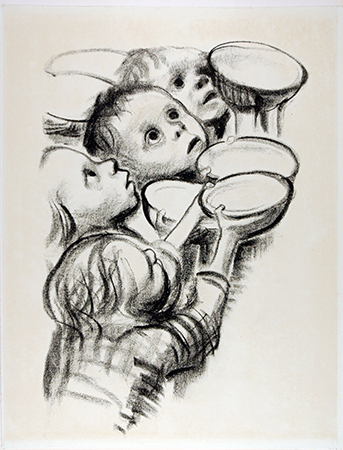Picture of the Week: Germany's Children are Starving by Kathe Kollwitz
March 28, 2022

Kathe Kollwitz was a German Expressionist who experimented with a variety of media throughout her career. Kollwitz began her art training as a painter. However, after being exposed to the writings and art of artist Max Klinger, who privileged the precision of drawing over “the free form of painting,” she transitioned to graphic arts. After 1890, she began exploring etching and sculpture, and eventually opted for lithography and woodcuts. Kollwitz was the first woman to be elected to the Prussian Academy in 1919 but was unfortunately expelled by the Nazis. While other German Expressionists were beginning to dabble in abstraction during the early twentieth century, Kollwitz maintained a naturalistic approach to her artmaking.
Aside from her diverse use of media, Kollwitz was an incredibly empathic artist. Her husband was a physician who treated proletarian families in Berlin, and her studio was situated in his medical clinic. Her proximity to her husband’s patients led Kollwitz to develop a “deep admiration for [the] working class.” Kollwitz’s art was dedicated “to the poor and oppressed, especially women and children.” Additionally, she was devastated by the death of her son, Peter, who died in combat in 1914 during World War I. This tragedy led Kollwitz to incorporate themes of sacrifice and mourning in her work. She created her art when Germany was suffering great turmoil from World War I and the German civil war.
Her 1924 lithograph Germany’s Children are Starving reflects the tragic period following these wars, as well as her empathy for the poor and oppressed. In this work, Kollwitz depicts children raising their bowls for food. She composes the work with a natural, simplistic approach, omitting any colors or details that could distract from the issue at hand. Kollwitz would have likely seen children in a similar situation while observing families in and around her husband's clinic.Their eyes and mouths are wide with hunger and desperation. Kollwitz does not include anyone providing food to the children in the composition. Rather, they raise their empty bowls in vain. The absence of food and aid for the children serves as a form of social critique, which is common in the art of Kathe Kollwitz. In this case, she is critiquing German society in the decade following World War I and the German civil war. Germany's children have been neglected; hence the title Germany’s Children are Starving. Despite Germany's post-war turmoil, Kollwitz communicates that the children must be prioritized, as they are the future of the nation.
Written by Angela Athnasios
Sources: "Kathe Kollwitz." moma.org, "Kathe Kollwitz." MoMA German Expressionism Collection.